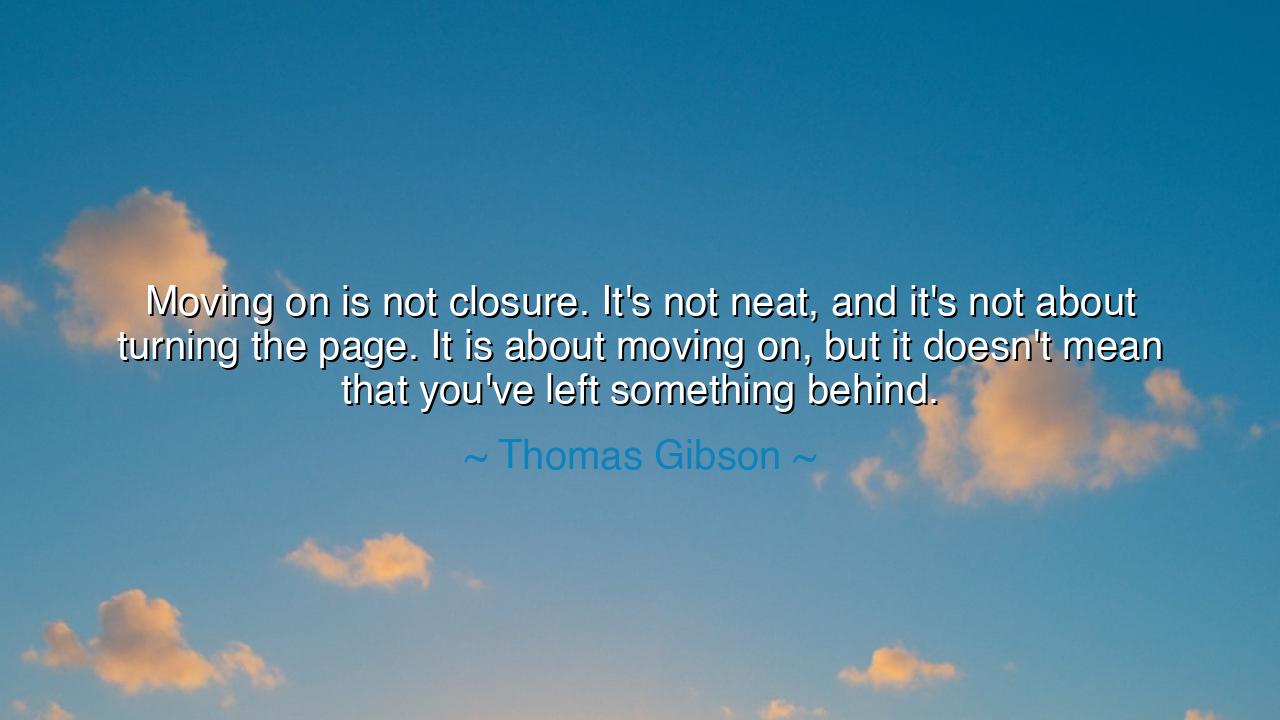
Moving on is not closure. It's not neat, and it's not about
Moving on is not closure. It's not neat, and it's not about turning the page. It is about moving on, but it doesn't mean that you've left something behind.






Hear the words of Thomas Gibson, spoken with the weight of lived truth: “Moving on is not closure. It's not neat, and it's not about turning the page. It is about moving on, but it doesn't mean that you've left something behind.” In this teaching lies a deep understanding of the human heart, for we often imagine healing as a final chapter, tied with a ribbon, set aside forever. But Gibson reminds us that life is rarely so clean. Moving on is not forgetting, nor is it erasing—it is walking forward while still carrying the imprint of what has shaped us.
The ancients, too, knew this. They spoke of memory as both burden and blessing. Odysseus, though he returned home to Ithaca, never fully left behind the wars of Troy or the trials of his wandering. He moved on, yes, but the scars and the memories traveled with him, shaping the man he had become. To demand closure as a final severing would have been impossible; to walk forward with the past woven into his being was the only true way. So it is with us all.
Closure is a word the heart invents to comfort itself, to imagine a clean severing of grief or love or pain. Yet Gibson unmasks this illusion. He tells us that life is messy, that the past does not vanish when we step into tomorrow. To move on is to acknowledge that some wounds never fully close, some bonds never fully break, and some chapters never truly end. But we continue anyway. This is not weakness—it is the deepest form of courage.
Consider the tale of Abraham Lincoln, who lost his beloved son Willie while serving as president. He could not find neat closure for such grief, nor could he turn the page as though it were a mere line in his life’s book. The loss remained within him, an ache that never departed. Yet he moved on—leading a nation through its darkest war, carrying both the weight of his sorrow and the strength it gave him. His journey reflects Gibson’s truth: moving on does not mean leaving something behind, but learning to live with it as part of oneself.
The wisdom here is clear: the past is never truly gone. Love, grief, mistakes, and triumphs—they remain woven into the fabric of our souls. To demand that we erase them is to deny who we are. Moving on is not about abandonment; it is about integration. It is the art of walking forward with all that has been, carrying memory not as a chain, but as a thread woven into the tapestry of our becoming.
What lesson must you take, O listener of wisdom? Do not torment yourself with the demand for perfect closure. Do not believe that healing means forgetting, or that progress means severing. Accept that life leaves marks, and that those marks are part of your story. To move on is not to walk away from your past, but to walk forward with it, transformed by its lessons.
Practical actions are these: when grief lingers, do not force yourself to close the door; instead, let it teach you endurance. When love ends, do not erase it; let it remain as part of the foundation of your heart. When mistakes haunt you, do not pretend they never happened; carry their lessons as tools for the future. In this way, you will move forward not empty, but whole, strengthened by every scar, every joy, every sorrow.
Thus remember Gibson’s wisdom: moving on is not closure—it is continuation. It is the courage to walk into tomorrow without needing to erase yesterday. It is not neat, but it is real, and it is the way of all who endure. Let your past walk with you, not as a prison, but as a companion, and you will find that moving on does not diminish you—it makes you complete.






AAdministratorAdministrator
Welcome, honored guests. Please leave a comment, we will respond soon